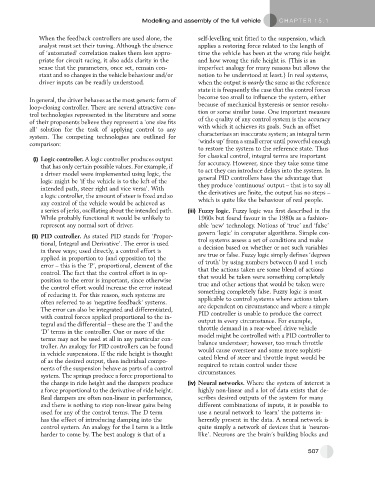Page 499 - Automotive Engineering Powertrain Chassis System and Vehicle Body
P. 499
Modelling and assembly of the full vehicle C HAPTER 15.1
When the feedback controllers are used alone, the self-levelling unit fitted to the suspension, which
analyst must set their tuning. Although the absence applies a restoring force related to the length of
of ‘automated’ correlation makes them less appro- time the vehicle has been at the wrong ride height
priate for circuit racing, it also adds clarity in the and how wrong the ride height is. (This is an
sense that the parameters, once set, remain con- imperfect analogy for many reasons but allows the
stant and so changes in the vehicle behaviour and/or notion to be understood at least.) In real systems,
driver inputs can be readily understood. when the output is nearly the same as the reference
state it is frequently the case that the control forces
become too small to influence the system, either
In general, the driver behaves as the most generic form of
because of mechanical hysteresis or sensor resolu-
loop-closing controller. There are several attractive con-
tion or some similar issue. One important measure
trol technologies represented in the literature and some
of their proponents believe they represent a ‘one size fits of the quality of any control system is the accuracy
all’ solution for the task of applying control to any with which it achieves its goals. Such an offset
system. The competing technologies are outlined for characterizes an inaccurate system; an integral term
comparison: ‘winds up’ from a small error until powerful enough
to restore the system to the reference state. Thus
for classical control, integral terms are important
(i) Logic controller. A logic controller produces output for accuracy. However, since they take some time
that has only certain possible values. For example, if to act they can introduce delays into the system. In
a driver model were implemented using logic, the general PID controllers have the advantage that
logic might be ‘if the vehicle is to the left of the they produce ‘continuous’ output – that is to say all
intended path, steer right and vice versa’. With the derivatives are finite, the output has no steps –
a logic controller, the amount of steer is fixed and so which is quite like the behaviour of real people.
any control of the vehicle would be achieved as
a series of jerks, oscillating about the intended path. (iii) Fuzzy logic. Fuzzy logic was first described in the
While probably functional it would be unlikely to 1960s but found favour in the 1980s as a fashion-
represent any normal sort of driver. able ‘new’ technology. Notions of ‘true’ and ‘false’
govern ‘logic’ in computer algorithms. Simple con-
(ii) PID controller. As stated PID stands for ‘Propor-
tional, Integral and Derivative’. The error is used trol systems assess a set of conditions and make
in three ways; used directly, a control effort is a decision based on whether or not such variables
applied in proportion to (and opposition to) the are true or false. Fuzzy logic simply defines ‘degrees
error – this is the ‘P’, proportional, element of the of truth’ by using numbers between 0 and 1 such
control. The fact that the control effort is in op- that the actions taken are some blend of actions
that would be taken were something completely
position to the error is important, since otherwise true and other actions that would be taken were
the control effort would increase the error instead something completely false. Fuzzy logic is most
of reducing it. For this reason, such systems are applicable to control systems where actions taken
often referred to as ‘negative feedback’ systems. are dependent on circumstance and where a simple
The error can also be integrated and differentiated, PID controller is unable to produce the correct
with control forces applied proportional to the in- output in every circumstance. For example,
tegral and the differential – these are the ‘I’ and the throttle demand in a rear-wheel drive vehicle
‘D’ terms in the controller. One or more of the model might be controlled with a PID controller to
terms may not be used at all in any particular con- balance understeer; however, too much throttle
troller. An analogy for PID controllers can be found would cause oversteer and some more sophisti-
in vehicle suspensions. If the ride height is thought cated blend of steer and throttle input would be
of as the desired output, then individual compo- required to retain control under these
nents of the suspension behave as parts of a control circumstances.
system. The springs produce a force proportional to
the change in ride height and the dampers produce (iv) Neural networks. Where the system of interest is
a force proportional to the derivative of ride height. highly non-linear and a lot of data exists that de-
Real dampers are often non-linear in performance, scribes desired outputs of the system for many
and there is nothing to stop non-linear gains being different combinations of inputs, it is possible to
used for any of the control terms. The D term use a neural network to ‘learn’ the patterns in-
has the effect of introducing damping into the herently present in the data. A neural network is
control system. An analogy for the I term is a little quite simply a network of devices that is ‘neuron-
harder to come by. The best analogy is that of a like’. Neurons are the brain’s building blocks and
507

